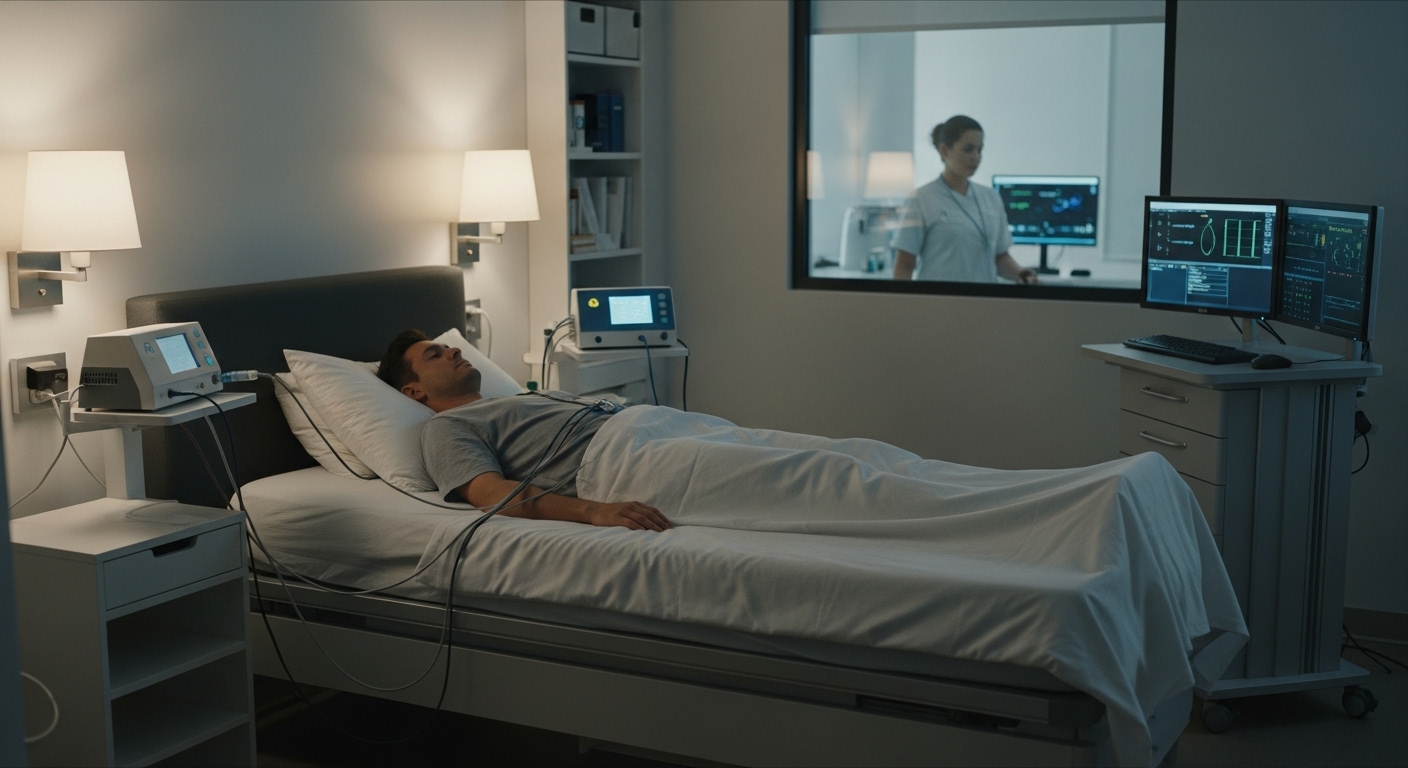
Sleep disorders encompass a variety of conditions that affect your ability to get restful sleep. These conditions can be acute or chronic and vary widely in symptoms and severity. They can range from insomnia, where you have trouble falling or staying asleep, to sleep apnea, where your breathing repeatedly stops and starts during sleep. Other disorders include restless legs syndrome and narcolepsy, each with its own set of challenges and health implications. The complexity of these disorders often requires a detailed understanding of individual sleep patterns, which is where sleep studies become invaluable.
Common Sleep Disorders
- Insomnia: Difficulty falling or staying asleep. Insomnia can be transient or persistent, often influenced by stress, anxiety, or lifestyle factors. Chronic insomnia may require a multi-faceted treatment approach, including behavioral therapy and medication.
- Sleep Apnea: Breathing interruptions during sleep. This disorder is commonly associated with snoring and can significantly impact cardiovascular health. Sleep apnea is often linked to obesity and other health conditions, necessitating a comprehensive treatment plan.
- Restless Legs Syndrome: Uncomfortable sensations in the legs with an urge to move them. This condition can disrupt sleep onset and maintenance, leading to daytime fatigue. Treatment typically involves addressing underlying causes and may include medication or lifestyle changes.
- Narcolepsy: Excessive daytime sleepiness and sudden sleep attacks. Narcolepsy can severely impact daily functioning and requires specific medical treatments to manage symptoms effectively.
Identifying the specific type of sleep disorder is the first step towards effective treatment, which is where sleep studies come in. By pinpointing the exact nature of the disorder, healthcare providers can tailor treatment plans that address the individual’s unique needs and promote better sleep health.
What is a Sleep Study?

A sleep study, also known as polysomnography, is a test used to diagnose sleep disorders. This comprehensive diagnostic tool records various physical activities while you sleep, including brain waves, heart rate, breathing patterns, and eye movements. The data collected during a sleep study is instrumental in understanding sleep architecture and identifying abnormalities that may be contributing to sleep disturbances. This comprehensive data helps doctors understand what’s happening in your body during sleep, providing a foundation for accurate diagnosis and treatment planning.
Types of Sleep Studies
There are several types of sleep studies, each tailored to diagnose different disorders. Understanding the differences can help you and your healthcare provider choose the most appropriate test:
- Overnight Sleep Test: Conducted in a sleep lab, this is the most common type of sleep study. It provides detailed information on various physiological parameters and is often used to diagnose a range of sleep disorders.
- Home Sleep Apnea Testing: A convenient option for diagnosing sleep apnea from the comfort of your home. This test is less comprehensive than a lab study but can be effective for diagnosing obstructive sleep apnea in patients with a high pre-test probability.
- Multiple Sleep Latency Test (MSLT): Measures how quickly you fall asleep in a quiet environment during the day, often used to diagnose narcolepsy. This test assesses the presence of excessive daytime sleepiness and the tendency to enter REM sleep quickly.
- Maintenance of Wakefulness Test (MWT): Assesses your ability to stay awake in a comfortable, quiet environment. This test is often used in occupational health settings to evaluate wakefulness in individuals who need to remain alert for safety reasons.
Each type of sleep study offers unique insights into sleep health, enabling targeted interventions that address specific disorders.
How Sleep Studies Diagnose Disorders
Sleep studies are vital for accurately diagnosing sleep disorders. They provide objective data that can confirm or rule out specific conditions, guiding treatment decisions.
Monitoring and Measuring
During a sleep study, various sensors are placed on your body to monitor a wide range of physiological activities. These measurements offer a detailed picture of your sleep cycle and identify disruptions:
- Brain Activity: Electrodes on the scalp measure brain waves to identify sleep stages and disruptions. This data helps differentiate between sleep phases and detect abnormalities like seizures or unusual sleep patterns.
- Eye Movements: Detects REM (Rapid Eye Movement) sleep, a crucial sleep stage associated with dreaming and memory consolidation. Irregularities in REM sleep can indicate certain disorders, such as narcolepsy.
- Heart Rate: Electrodes on the chest track heart activity, providing insights into cardiovascular health during sleep. Irregular heart rhythms may suggest underlying health issues that need attention.
- Breathing: Sensors near the nose and mouth measure airflow and oxygen levels, which are critical for diagnosing sleep apnea. Variations in these parameters can indicate obstructions or central apnea events.
- Muscle Activity: Electrodes on the chin and legs monitor muscle tone and movements, useful for diagnosing conditions like REM sleep behavior disorder or periodic limb movement disorder.
Analyzing the Data
Once the sleep study is complete, a sleep specialist analyzes the collected data. They look for patterns and irregularities that indicate specific sleep disorders. For instance, pauses in breathing and drops in oxygen levels may suggest sleep apnea, while frequent awakenings might point to insomnia. The analysis involves correlating the data with reported symptoms to provide a comprehensive diagnosis. This process is crucial for developing an effective treatment plan that addresses the root causes of sleep disturbances and improves overall sleep quality.
What to Expect in a Sleep Study
by Boston Public Library (https://unsplash.com/@bostonpubliclibrary)
If you’re scheduled for a sleep study, knowing what to expect can ease any anxiety. Understanding the process can help you feel more comfortable and prepared, ensuring a smoother experience.
Preparing for the Study
- Consultation: Your doctor will explain the procedure and what to bring. It’s important to discuss any medications you’re taking, as some may need to be paused or adjusted before the study.
- Avoid Caffeine and Alcohol: These substances can interfere with sleep quality and the accuracy of the study results. It’s best to refrain from consuming them at least 24 hours before the test.
- Pack Comfort Items: Bring pajamas, a book, or anything that helps you relax. Familiar items can create a sense of normalcy and comfort, making it easier to fall asleep in a new environment.
During the Study
- Arrival: You’ll check into a sleep center or have equipment delivered for a home test. The staff will guide you through the setup process and answer any questions.
- Setup: Technicians will attach sensors to your body. These sensors are non-invasive and designed to be as comfortable as possible.
- Sleep Environment: The room will be comfortable and quiet, similar to a hotel room. This setting is designed to mimic a normal sleep environment, minimizing disruptions.
- Overnight Monitoring: You’ll sleep as usual while the equipment records data. Technicians monitor the data in real-time to ensure everything is functioning correctly.
Post-Study
- Data Analysis: Specialists review the data to identify any issues. This step involves a detailed examination of the recorded information to pinpoint abnormalities.
- Follow-Up: Your doctor will discuss the results and potential treatment options. This consultation is an opportunity to address any questions or concerns and establish a treatment plan.
Benefits of Sleep Study Testing
Sleep studies offer numerous benefits in diagnosing and managing sleep disorders. They provide a comprehensive view of sleep health, facilitating more effective interventions.
Accurate Diagnosis
Sleep studies provide a detailed picture of your sleep patterns, leading to an accurate diagnosis. This is crucial for developing an effective treatment plan tailored to your needs. By understanding the specific nature of your sleep disorder, healthcare providers can recommend interventions that are more likely to succeed.
Identifying Underlying Issues
Some sleep disorders are linked to other health conditions, such as heart disease or obesity. Sleep studies can uncover these connections, allowing for comprehensive care. By addressing both the sleep disorder and its related health issues, you can achieve better overall health outcomes.
Guiding Treatment
With precise data from a sleep study, doctors can recommend appropriate treatments, such as CPAP therapy for sleep apnea or behavioral therapy for insomnia. This targeted approach ensures that treatments address the specific causes of sleep disturbances, increasing their effectiveness.
Improving Quality of Life
Proper diagnosis and treatment of sleep disorders can significantly enhance your quality of life. You’ll experience better sleep, improved mood, and increased daytime alertness. These improvements can positively impact your personal and professional life, contributing to overall well-being.
Conclusion
Sleep studies are an invaluable tool in diagnosing sleep disorders. They provide the insights needed to understand what’s disrupting your sleep and help guide effective treatment. If you suspect you have a sleep disorder, consult your doctor about the possibility of undergoing a sleep study. With the right diagnosis and treatment, you can look forward to restful nights and more energetic days.
Remember, a good night’s sleep is not just a luxury but a necessity for a healthy life. Don’t hesitate to seek help if you’re struggling with sleep issues. Addressing sleep disorders proactively can lead to significant health benefits and improve your overall quality of life.








